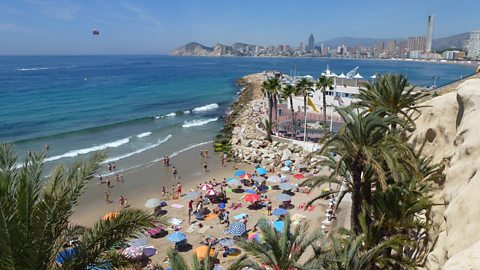Mass tourism to honeypot sites
Mass tourism involves tens of thousands of people going to the same resort, or honeypot siteA popular visitor attraction or area, where large numbers of people visit., often at the same time of year. It is the most popular form of tourism as it is usually the cheapest way to holiday, and is often sold as a package dealA holiday that includes flights, hotel and transfers..

Governments and local people often support mass tourism because it generates a lot of income for local areas. However, some view such tourism as unsustainableResources which cannot be used forever and cannot be replaced or recycled after they are used. The use of fossil fuels is unsustainable, for example. , because the effect of so many tourists in one area can lead to the destruction of the natural and cultural landscapes on which people depend to attract the tourists in the first place.
Advantages
- Jobs are generated in many areas - in the construction, travel, food and other service-related industries.
- It brings foreign exchange into the country.
- The multiplier effectThis occurs when a positive change happens, which then has a knock-on effect on other businesses. For example a new office may open, which leads to an increase in lunchtime sandwich sales at the local caf├® and more bus passengers. spreads wealth into the local community.
- Roads, rail, electricity services, etc all need improving - local people also benefit from these infrastructure developments.
- Provides local government with money to invest in schools, healthcare and social services.
Disadvantages
- Multinational companies often control these holidays and much of the profit leaves the country.
- Jobs can be seasonal and low paid. People can therefore find themselves out of work at the end of the season.
- Tourists consume huge amounts of resources including food and water in areas where these are often scarce.
- Land is lost from farming to tourist developments.
- Fragile ecosystems, eg sand dunes, may be destroyed.
- New roads, airports and increased traffic cause pollution and environmental damage.
Rural tourism
Rural tourism encourages the public to enjoy the countryside. It is a thriving industry in the UK, due largely to its 15 national parks, eg Snowdonia in Wales, the Cairngorms in Scotland and the Lake District in the north of England.
This type of tourism provides jobs and brings in revenue into the local area, but can also create issues such as traffic congestion, pollution and damage to natural landscapes (due to high numbers of tourists visiting).